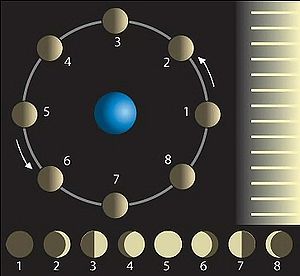|
Vikidia currently has 4,625 articles. Improve it! |
|
Join Vikidia: create your account now and improve it! |
Moon
The Moon (capitalized) is the name for the Earth's moon. It is a natural satellite, meaning an object that orbits another - in this case, the Earth, held by Earth's gravity.
The Moon can be seen from Earth. The Moon is actually very large, about a quarter the size of the Earth, but because it is far away it looks quite small. The gravity on the Moon is one-sixth of the Earth's gravity. It means that a person would be 6 times lighter on the Moon than on Earth. The moon is a rocky and dusty place.
The name "Luna" is used in science and literature. This word appears in the adjective "lunar" meaning "of the Moon." In fact, many planets have their own moons orbiting them. Astronomers have detected them and given them names.
Characteristics[edit | edit source]
Gravity[edit | edit source]
Because it's smaller in size, the Moon has less gravity than Earth (only 1/6 of the amount on Earth). So if a person weighs 60 pounds on Earth, that person would only weigh 10 pounds on the Moon.
But even though the Moon's gravity is weaker than the Earth's gravity, it is still there. If a person threw a ball while standing on the Moon, it would still fall back down. However, it would fall much more slowly. A person who jumped as high as possible on the Moon would jump higher than on Earth but still fall back to the ground. That person could also fall badly on the Moon and not be hurt at all, because the moon's gravity would not pull as hard as the Earth's gravity does.
Atmosphere[edit | edit source]
The Moon has no atmosphere. Without an atmosphere, people are not protected from heat or cold. Because of this, astronauts have to wear very heavy spacesuits for protection and to carry oxygen to breathe. Of course, since the Moon does not have a lot of gravity, the spacesuit would not be as heavy as it would be on Earth.
Therefore, the Moon has no rain or wind, so footprints would never wear away naturally.
At last, because there is no atmosphere to protect the Moon from the rocks that fall from outer space, they crash right into the Moon and make big dents called craters. The Moon has thousands of these craters.
Color of the lunar sky[edit | edit source]
In the Earth, the sky is blue because the blue frequency of the Sun's light rays bounce off the gases in the atmosphere, making it look like the sky is blue. But on the Moon, because there is no atmosphere, the sky looks black, even in the daytime.
Phases[edit | edit source]
The Moon appears lit up as it goes around (orbits) the Earth. The Moon gives out no light—we can only see the parts that are reflecting light from the Sun. This means sometimes we can see the whole Moon and other times only parts of it. These different stages are called lunar phases. It takes the Moon about 29.53 days (29 days, 12 hours, 44 minutes) to complete the cycle, from big and bright to small and dim and back to big and bright.
As the Moon passes between the Earth and Sun, this phase is called the "new moon". The next phase of the moon is called the waxing crescent, followed by the first quarter, waxing gibbous, then to a full moon, appearing as a complete circle. A full moon occurs when the Moon is opposite the Earth, the farthest away from the Sun. As the Moon continues its orbit is become a waning gibbous, third quarter, waning crescent, and finally back to a new moon.
People used the Moon to measure time and present day months are approximately equal in time to a complete lunar cycle.
Because the Moon is tidally locked (always faces the same way) towards Earth there is a half of the moon that cannot be seen from Earth. This is called "the dark side of the Moon" even though the sun does shine on it.
History of exploring the Moon[edit | edit source]
The Moon has fascinated people since there were people to see it. People often dreamed of standing on the Moon and looking at Earth.
Before people stood on the Moon, some of the big countries in the world, the United States and Russia (which used to be part of the USSR) sent robots to the Moon. These robots would fly around, crawl, or in the case of Luna 2, crash into the Moon. The robots were the first things that humans made that touched the Moon.
Humans finally landed on the Moon on 21 July 1969. Astronauts Neil Armstrong, Buzz Aldrin, landed their space probe (the Eagle) on the surface of the Moon. Then, as half the world watched him on television, Armstrong climbed down the ladder of the Eagle and was the first to touch the Moon. Later, Buzz Aldrin hops out of the Eagle, and together, they put the American flag near the spot where they landed. They explored around collecting rocks for about an hour before leaving.
More people landed on the Moon between 1969 and 1972, when the last spaceship, Apollo 17 visited. Eugene Cernan of Apollo 17 was the last person to touch the Moon since 2008.
| Astronomy Portal — All articles about astronomy! |


